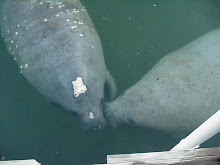"There I Grew Up..." A. Lincoln
The Colonel and I had just left New Harmony, Indiana. The weather was overcast and cool as we arrived at the Lincoln Boyhood National Memorial (Lincoln City, Indiana).
Abraham Lincoln grew from youth (7 years old) to manhood (21 years old) on this southern Indiana soil. Many of his character and moral traits were formed and nurtured here. The Lincoln's lived here for fourteen years (1816-1830).
The memorial's building is beautiful and impressive. The steps lead to a demilune of limestone blocks that make up the building.
On the limestone walls are reliefs of Lincoln's life. His years in Kentucky, Indiana, Illinois and Washington D.C.
Inside the building is a museum and two chapels, one at each end. There were pictures of Lincoln's parents, Thomas and Nancy and his stepmother Sarah.
Thomas was said to be good humored, patient and kind. He had a flair for storytelling. He believed in honesty and malice towards none. Abe must have gotten his honesty and clean notions of living, as well as his kind heart from his father. Thomas was a carpenter and one of the cabinets he made was on display.
There was an interesting diorama in the museum. It depicted the burial of Abraham's birth mother, Nancy Hanks Lincoln.
In 1818, Nancy died of Milk Sickness, Abe was 9 years-old at the time. Milk Sickness happened when someone drank the milk of a cow that had eaten the White Snake Root plant.
Milk Sickness was also called the Puking Fever. Some of the symptoms included: vomiting, loss of appetite, weakness, muscle stiffening, severe constipation and finally coma. Nancy Hanks Lincoln died two weeks after her first symptom.
When she was alive she planted the seeds of Abe's intellectual curiosity despite her lack of formal education. She recognized the importance of learning and worked hard to impress that upon her young son (as well as Abe's older sister, Sarah).
"She was a noble woman, affectionate, good, kind..." A. Lincoln
After one year of mourning, Thomas Lincoln went back to Kentucky to marry Abe's stepmother, Sarah Bush Lincoln. She was a widow with three children. Thomas knew Sarah when he and Nancy lived in Kentucky, before they moved to Indiana.
When Sarah Bush Lincoln first arrived to her new home in Indiana she said it was, "wild and desolate" but the cabin Thomas had built was, "good, tolerably comfortable".
Sarah noticed that her new stepson Abe was intelligent and she picked up where his mother Nancy had left off. She guided him along the path of knowledge by encouraging him and creating in every possible way, an atmosphere suited for to study. She gifted three books to Abe. As an adult Abe was close to Sarah and called her "Mother". Sarah died in 1869, four years after her stepson was assassinated.
"She proved to be a good and kind mother"...A. Lincoln
The Colonel and I exited the museum and proceeded to the grave of Nancy Hanks Lincoln. In 1900 Robert Todd Lincoln gave $1000 for the care of his grandmother's grave. This stimulated Spencer County to appropriate $800 for the purchase of 16 acres surrounding the grave site. Eventually this led to the establishment of the Lincoln Boyhood National Memorial.
We walked up a slight incline to a flagpole at the top of the rise. Behind the wooded knoll was Nancy Hanks Lincoln's grave.
The Colonel and I noticed that there were an untold number of pennies at the base of Nancy's headstone. We added our two cents worth to the pile of pennies. What an interesting and fitting custom as Nancy's son's visage is on the little copper coin.
On the path beyond Abe's mother's grave is where the Lincoln's lived when they came to Indiana in the fall of 1816. Thomas and Nancy packed their belongings and their two children, Sarah, 9 and Abraham, 7 and left Kentucky bound for the new frontier of Southern Indiana. Thomas claimed 160 acres near Little Pigeon Creek Community. He set about building a cabin for the family and they carved a new life out of the largely unsettled wilderness. In time, Thomas cleared the fields, improved the cabin and outbuildings, and used his carpentry skills to establish himself within the community.
The Lincoln cabin is no longer standing but the remains of the hearth and foundation were discovered and bronze casts were made. The casts are behind a wall now and it is amazing how small the cabin was for a family of four.
We walked a little further on the wooded path and passed a Lincoln field ready for plowing.
There were many outbuildings on the homestead: a smokehouse, Thomas Lincoln's workshop and a barn.
There were pretty chickens and lovely gardens.
There were living historians on the site. They invited us into the cabin where a roaring fire was keeping everyone toasty. Before we left the homestead the historians had to gather the chickens before the park closed in a couple of hours.
Down a path that went past the Lincoln cabin was the spring the Lincoln's used when they lived on this land. It was fun to think that young Abraham had once walked here many times to get water for his family.
After visiting the spring we made our way back towards the Lincoln cabin and said our good byes to the living historians.
We retraced our steps through the woods, past Nancy Hanks Lincoln's grave and back down to the parking lot. Our visit to Abraham Lincoln's boyhood home was done. We had one more historical stop in Indiana before we crossed into Kentucky. We would have much to see in Kentucky before we continued our way back to Florida.
(Note: The Colonel and I watched an interesting movie about the Lincoln's and when they lived in Indiana. The movie is called The Better Angels. It was a very good movie and it helped us to know what the Lincoln's lives would have been like in the Indiana wilderness).





































































Wonderful telling of your journey.
ReplyDeleteThanks!
Delete